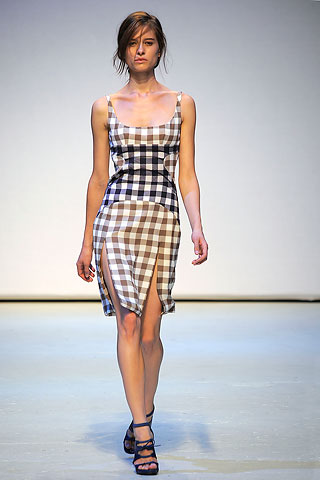Street trends have inspired designers since fashion as we know it began. From Hip Hop to Hippies modern culture has created a wealth of design ideas for inspiring the looks that are shown in collections today.
The major street fashion categories for the 20th century are: Zoot Suits (1930's-1940's), Teddy Boys (1950's), Beatniks (1950's), Mod (1960's), Hippies (1960's), Punk (1970's), Disco (1970's-1980's), and Hip Hop (1980's)
Zoot Suits
Zoot Suits
A zoot suit (occasionally spelled zuit suit) is a suit with high-waisted, wide-legged, tight-cuffed,pegged trousers, and a long coat with wide lapels and wide padded shoulders. This style of clothing was popularized by African Americans, Mexican Americans, Puerto Ricans, Italian Americans, and Filipino Americans during the late 1930s and 1940s.In England bright-colored zoot suits with velvet lapels that bore a slight resemblance to Edwardian clothing were worn by Teddy boys.
 | |
| Fashion Illustration of Zoot Suits "Zoot Suit" Inspired Dior Homme Fall 2008 |
Teddy Boys
Traditionally Teddy Boys or Neo-Edwardians of the 1950’s sported the "Drape" a long knee length, single breasted wool jacket with narrow contrasting lapels and cuffs either of velvet or satin and plenty of pockets. They wore contrast or matching narrow drainpipe trousers, brocade waistcoats, stiff shirts and shoestring ties or bootlace slim Jim ties topped off with suede shoes. Teds also wore crepe soled shoes which helped with the dance movements of jiving.
 |
| "Teddy Boys" circa 1950's |
 |
| "Teddy Boy" inspired fashion by Band of Outsiders Fall 2010 |
As the trend for a beatnik look developed in the 1960's, oversized chunky long sweaters with huge cowl collars were worn over slim fitting pencil skirts or slacks with stirrups. The girls usually had a French pleat hairstyle or showed the start of a beehive. Wearing all black was a favorite choice for beatniks.
 | |||
| Bob Dylan 1960's |
 | |||
| "Beatnik" inspired fashion by Miu Miu Fall 2010 |
Mod
An unconventionally modern style of fashionable dress originating in England in the 1960s. A youth subculture that began in London in the early 1960s; a working-class movement with highly stylized dress and short hair; listened to rhythm and blues music and travelled on motor scooters.
Color played a big role in defining the look. The muted and pastel palette of Fifties fashions gave way to bright, bold color often splayed in geometric patterns. From daywear to Day Glo in less than a decade. A word about the word - Mod. Mod for modern, which in its purest use meant minimalist. Arguably there is nothing minimal about most Mod fashion, but that is the origin.
Color played a big role in defining the look. The muted and pastel palette of Fifties fashions gave way to bright, bold color often splayed in geometric patterns. From daywear to Day Glo in less than a decade. A word about the word - Mod. Mod for modern, which in its purest use meant minimalist. Arguably there is nothing minimal about most Mod fashion, but that is the origin.


















No comments:
Post a Comment